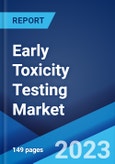The global early toxicity testing market size was valued at USD 1.37 Billion in 2024. Looking forward, the market is forecast to reach USD 2.57 Billion by 2033, exhibiting a CAGR of 6.84% from 2025-2033. Europe currently dominates the market, holding a market share of over 34.0% in 2024. The market is experiencing significant growth driven by increasing drug development activities, stringent regulatory requirements, and advancements in alternative testing methods. Growing demand for predictive toxicology solutions and reduced animal testing further fuels market growth, contributing to the expanding early toxicity testing market share.
Early toxicity testing of new compounds is used to develop drugs and the extension of the therapeutic potential of existing molecules. It is carried out at pre-clinical stages on various biological systems to investigate the species, organs, and dose-specific toxic effects of a product. It can be performed in multiple ways, including in vivo on animals, in vitro in laboratories using assays, and in silico on a computer. It is also utilized for studying accidental exposures to a substance. Nowadays, the high-cost impact of late-stage failures of drug candidates is encouraging pharma companies to conduct early toxicity testing on investigational products.
2. What is the future outlook of early toxicity testing market?
3. What are the key factors driving the early toxicity testing market?
4. Which region accounts for the largest early toxicity testing market share?
5. Which are the leading companies in the global early toxicity testing market?
Early toxicity testing of new compounds is used to develop drugs and the extension of the therapeutic potential of existing molecules. It is carried out at pre-clinical stages on various biological systems to investigate the species, organs, and dose-specific toxic effects of a product. It can be performed in multiple ways, including in vivo on animals, in vitro in laboratories using assays, and in silico on a computer. It is also utilized for studying accidental exposures to a substance. Nowadays, the high-cost impact of late-stage failures of drug candidates is encouraging pharma companies to conduct early toxicity testing on investigational products.
Early Toxicity Testing Market Trends:
Exposure to toxic chemicals occurs through skin contact, oral intake, or inhalation. Therefore, early toxicity testing has become a crucial process in various industrial applications for determining the degree of toxicity in products and ensuring that they are safe for human consumption and the environment. For example, it is extensively utilized in the food and beverage (F&B) industry to identify the adverse effects and characterize potential toxicants in products. Moreover, the rising prevalence of diseases and the requirement of novel drugs and biological products are encouraging the adoption of early toxicity testing to prevent the failure of candidate drugs at clinical trials. In addition, stringent regulations relating to public health welfare imposed by regulatory authorities are positively influencing the demand for early toxicity testing to determine the viability of drugs required for regulatory approval. Apart from this, the increasing usage of pesticides can pose risks to human health, which is promoting the use of early toxicity testing in the agriculture industry. Furthermore, the escalating demand for cosmetic products is expanding the application of early toxicity testing of cosmetic ingredients worldwide.Market Segmentation:
This report provides an analysis of the key trends in each segment of the global early toxicity testing market, along with forecast at the global, regional, and country levels from 2025-2033. The market has been categorized based on technique and end user.Breakup by Technique:
- In Vivo
- In Vitro
- In Silico
Breakup by End User:
- Pharmaceuticals Industry
- Food Industry
- Chemicals Industry
- Cosmetics Industry
- Others
Breakup by Region:
- North America
- United States
- Canada
- Asia-Pacific
- China
- Japan
- India
- South Korea
- Australia
- Indonesia
- Others
- Europe
- Germany
- France
- United Kingdom
- Italy
- Spain
- Russia
- Others
- Latin America
- Brazil
- Mexico
- Others
- Middle East and Africa
Competitive Landscape:
The competitive landscape of the industry has also been examined along with the profiles of the key players being Agilent Technologies Inc., Bio-Rad Laboratories Inc., Bruker Corporation, Charles River Laboratories International Inc., Danaher Corporation, Enzo Biochem Inc., Eurofins Scientific SE, Evotec A.G., Merck KGaA, PerkinElmer Inc., SGS S.A., Thermo Fisher Scientific Inc. and WuXi AppTec.Key Questions Answered in This Report
1. How big is the early toxicity testing market?2. What is the future outlook of early toxicity testing market?
3. What are the key factors driving the early toxicity testing market?
4. Which region accounts for the largest early toxicity testing market share?
5. Which are the leading companies in the global early toxicity testing market?
Table of Contents
1 Preface3 Executive Summary10 Value Chain Analysis12 Price Analysis
2 Scope and Methodology
4 Introduction
5 Global Early Toxicity Testing Market
6 Market Breakup by Technique
7 Market Breakup by End User
8 Market Breakup by Region
9 SWOT Analysis
11 Porters Five Forces Analysis
13 Competitive Landscape
List of Figures
List of Tables
Companies Mentioned
- Agilent Technologies Inc.
- Bio-Rad Laboratories Inc.
- Bruker Corporation
- Charles River Laboratories International Inc.
- Danaher Corporation
- Enzo Biochem Inc.
- Eurofins Scientific SE
- Evotec A.G.
- Merck KGaA
- PerkinElmer Inc.
- SGS S.A.
- Thermo Fisher Scientific Inc. and WuXi AppTec.
Methodology

LOADING...
Table Information
| Report Attribute | Details |
|---|---|
| No. of Pages | 138 |
| Published | May 2025 |
| Forecast Period | 2024 - 2033 |
| Estimated Market Value ( USD | $ 1.37 Billion |
| Forecasted Market Value ( USD | $ 2.57 Billion |
| Compound Annual Growth Rate | 7.2% |
| Regions Covered | Global |
| No. of Companies Mentioned | 12 |









